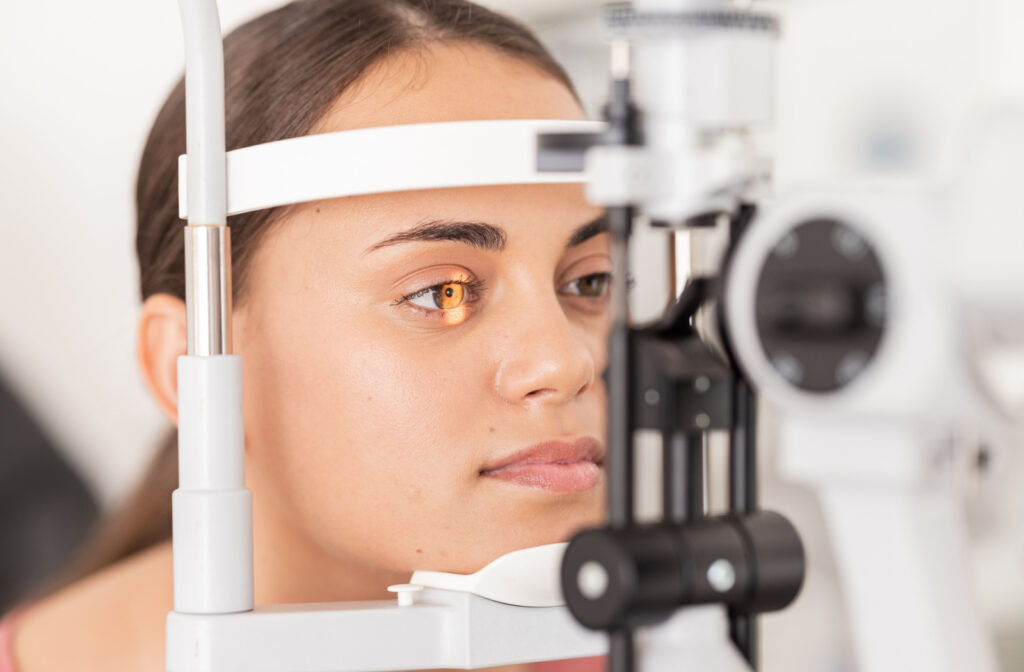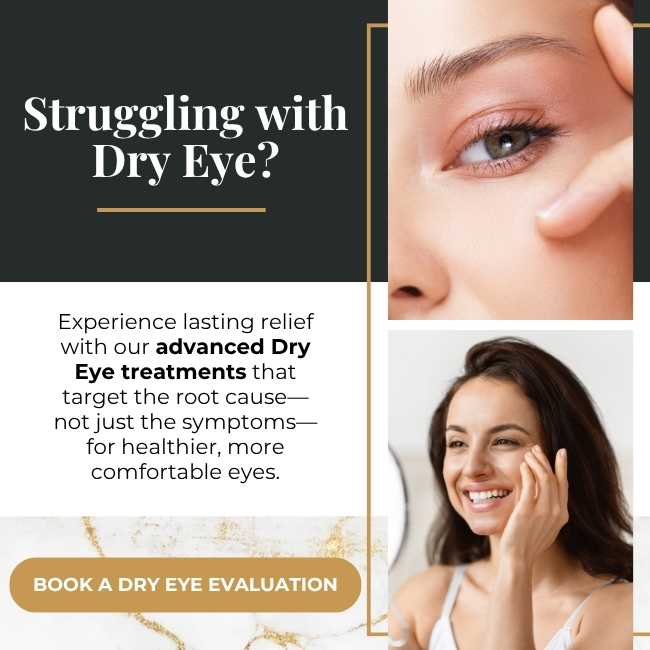Dry eyes can be frustrating and chronic. Your optometrist can help you find treatment and get relief, but dry eyes can lead to irritation, discomfort, and more if you don’t seek help.
Dry eyes and headaches sometimes occur together, and people with certain types of headaches are more likely to experience dry eyes, but more research is needed to fully understand the relationship.
Dry eye syndrome leaves your eyes exposed and vulnerable to outside contaminants, and your eyes need to work harder to compensate. Headaches and dry eyes also share common symptoms, like light sensitivity and discomfort, which can exacerbate the other condition, leading to a symptom loop.
What Is Dry Eye Disease?
Dry eye disease is a common and progressive eye disease that develops because your eyes don’t produce enough tears or because your eyes produce tears that are poor quality.
The most common cause is the latter, poor quality tears which lead to evaporative dry eyes. Your eyelids are lined with Meibomian glands which are responsible for producing oil that makes up the outermost layer of your tears. These oils stop the tear film from evaporating. If your tears lack sufficient oil, your tear film evaporates very quickly leaving your eyes dry..
Signs & Symptoms of Dry Eye
Recognizing dry eyes might seem straightforward, but symptoms can range in type and severity. Some can be subtle, while others are more severe. Here are some common symptoms:
- Stinging or burning eyes
- Light Sensitivity
- Red or irritated eyes, especially in windy or smoky environments
- Watery eyes
- Blurred or fluctuating vision
- Difficulty with driving at night
- Eye fatigue that worsens throughout the day
What Causes Dry Eyes?
While there are 2 primary causes of dry eyes, there are many reasons that contribute to and cause dry eye disease. Environmental factors often play a significant role—if you live in an area that’s particularly dry, windy, or smoky, your tears will evaporate more quickly, and you will experience dry eye symptoms.
Dry eyes can often be caused by:
- Age, because our bodies tend to produce fewer tears as we get older
- Certain medications, including antihistamines and antidepressants
- Medical conditions like diabetes, thyroid disorders, or Sjögren’s syndrome
- Prolonged contact lens wear
- Nutritional deficiencies
The Link Between Dry Eyes & Headaches
Headaches can cause symptoms like light sensitivity, discomfort, and blurry vision, which can all mimic the signs of dry eyes. Since your eyes need to work harder when they’re dry, this can put more strain on your visual system, which can then cause your headache to worsen.
Several studies have linked migraine headaches and dry eyes. A 2017 study found that 14.4% of those with migraines also reported a dry eye diagnosis, compared to 8.2% without. Additionally, a 2019 study showed that individuals with migraines were 1.42 times more likely to have a dry eye diagnosis.
However, there’s no clear causal connection between migraines and dry eyes, leaving uncertainty about whether one causes the other or if there’s another explanation. Migraine triggers vary, and for some individuals, eye strain or dry eyes may be a trigger. It’s also possible that both complaints share triggers, such as neck pain, light exposure, or prolonged screen use.
Are Dry Eyes Treatable?
Dry eyes can be managed effectively with the right treatment. Depending on your case of dry eyes, treatment can range from lifestyle changes to prescription medication prescribed by your optometrist.
At LUMINANCE VISION, our doctors will determine the root cause of your dry eye disease and treat the cause in addition to addressing your symptoms. If you’re looking to stop dry eye disease progression and find relief, our doctors may recommend:
- InMode Forma-I Radiofrequency treatment (RF), which uses energy waves applied around your eyes to melt, unclog and release oils plugging up your Meibomian glands..
- Lumenis Optilight or Inmode Lumecca Intense pulsed light therapy (IPL), which uses light energy applied to the skin around the eyes and the eyelids to close off abnormal vessels around those eyes that keep your eyes inflamed, red, and uncomfortable from dry eye disease.
- Meibomian gland expression, which applies gentle pressure to the eyelid to break up and squeeze out oil blockages. This approach works best when combined with other treatments, like IPL or RF.
- Eyelid hygiene and eyelid exfoliation, which aim to remove bacteria and mites plaque buildup in the eyelash margin which perpetually plug up the Meibomian glands.
- Low Level Light Therapy, which utilizes red and blue light to stimulate tear production, increase Meibomian gland oil production, and reduce inflammation to improve both signs and symptoms of dry eye disease.
- Punctal plugs, which block your tears from draining out of the eyes and keep your tears on the surface of your eyes longer.
These treatments are non-invasive, require no downtime and lead to long lasting results to help you eliminate the causes and find relief from dry eye disease.
Tips for Preventing Dry Eyes
While dry eye disease is treatable, there’s even more good news: you can incorporate these habits to lower the risk of developing dry eyes:
- Stay hydrated. Drinking water helps maintain moisture levels in the body, including the eyes.
- Protect your eyes. Wear sunglasses on windy days, and use a humidifier indoors during dry seasons.
- Add nutritional supplements. Take 2,000mg per day of quality omega-3 to support healthy tear production. Ask our team for the doctor recommended fish oil you can purchase at Luminance Vision.
- Avoid smoke and pollutants. These conditions can exacerbate dry eye symptoms.
- Avoid tobacco use. Smoking and tobacco can lead to inflammation.

How to Find Relief from Your Dry Eyes
If you’re battling dry eyes or headaches, visit us at Luminance Vision. Our doctors will diagnose your condition and create the right treatment plan for you. Imagine experiencing comfortable and beautiful eyes throughout your day. It is possible, so request an appointment with our team today!




